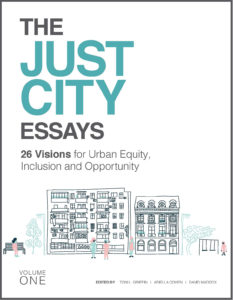“Five years ago, the Harvard Graduate School of Design’s Just City Lab published The Just City Essays: 26 Visions of Inclusion, Equity and Opportunity. The questions it posed were deceptively simple: What would a just city look like? And what could be the strategies to get there? These questions were posed to mayors, architects, artists, philanthropists, educators and journalists in 22 cities, who told stories of global injustice and their dreams for reparative and restorative justice in the city.
 These essays were meant as a provocation, a call to action. Now, during these times of dissonance, unrest, and uncertainty, their contents have become ever more important. For the next 26 weeks [starting June 15, 2020], the GSD and the Just City Lab will republish one essay a week here and at designforthejustcity.org. We hope they may continue conversations of our shared responsibility for the just city.
These essays were meant as a provocation, a call to action. Now, during these times of dissonance, unrest, and uncertainty, their contents have become ever more important. For the next 26 weeks [starting June 15, 2020], the GSD and the Just City Lab will republish one essay a week here and at designforthejustcity.org. We hope they may continue conversations of our shared responsibility for the just city.
We believe design can repair injustice. We believe design must restore justice, especially that produced by its own hand. We believe in justice for Black Americans. We believe in justice for all marginalized people. We believe in a Just City.”
—Toni L. Griffin, Professor in Practice of Urban Planning, founder of the Just City Lab, and editor of The Just City Essays
How to Build a New Civic Infrastructure
By Ben Hecht
In the United States of America, cities have long been gateways to opportunity. For centuries, people from all over the country and the world, including my own grandparents, came to our cities chasing the promise of a better life. America’s bargain with its citizens, rich and poor, was in many ways a model for the world.
Today, U.S. cities produce 85 percent of the nation’s GDP, are home to more than 50 percent of the population, and spend billions of dollars annually to educate, house and protect their citizens. Meanwhile, American cities are undergoing a major demographic shift. By 2040, America will be a majority-minority nation. And events in Ferguson and Baltimore have underscored the destructive nature of existing disparities of income, education and opportunity between whites and non-whites.
Addressing these disparities is one of the key social issues of our time. But our current trajectory is too slow, obsessed with short-term wins and incrementalism, where leaders are constantly reinventing the wheel instead of building on the work of those who came before them. We celebrate improvements in one school on one block while tiptoeing around the fact that it is the entire system that needs fixing. We tell heartwarming stories about 100 kids served or 100 young adults placed in good jobs while averting our eyes from the millions more who remain disconnected from opportunity. We talk about how far we have come since the civil rights movement, but are uncomfortable with discussing how far we still must go to achieve true racial equity. Unless we ferociously change course, the new American majority will be less educated, less prosperous and less free.
To build truly just cities, we need a new type of urban practice aimed at achieving dramatically better results for low-income people, faster. This new urban practice will require cities to get key public, private and philanthropic leaders to work together differently, to better harness impact investing dollars, and to leverage technology to engage all residents in solutions. Continue reading on designforthejustcity.org…
